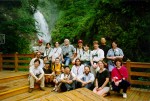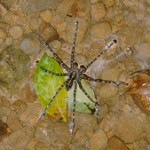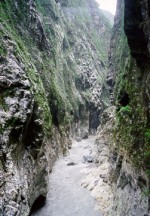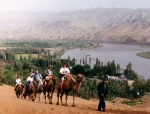Contributed by participating students and Christine French, International Programs, LTER Network Office
In June 1998, fourteen scientists and students from US LTER sites had the extraordinary opportunity to visit five LTER sites and related ecological research facilities in Taiwan and China. Their trip reciprocated a visit in 1997 when 16 students and junior scientists from Taiwan, Japan and Mongolia visited the North Temperate Lakes, Sevilleta, and Andrews Forest sites in the US (see LTER Network News (11)1 p.20). Both trips received generous funding from the Intl. Division of NSF as well as the host countries.
While the Network Office coordinated these trips, scientists at any LTER site are encouraged to organize visits with one or more partners in any part of the world.
The International LTER Network is growing rapidly. Sixteen countries currently offer well-equipped field stations for long-term comparative research on virtually every environment being studied in the US Network. ILTER scientists are eager to collaborate with US partners at any level, from exchanges of data or students to initiating long term joint comparative studies. Many of the networks now have their own web sites, and general information about 15 of the networks is available in The International Long Term Ecological Network published by the Network Office in July 1998. Both information sources can be accessed through the ILTER web site at http://www.ilternet.edu.
The following description of the trip to Asia is compiled from reports by Tim Bergsma (KBS), Matt Luck (CAP), Christine May (AND), Paul O’Connor (LUQ), Tom O’Keefe (NTL) and Alex Sloan (LUQ). For more information about their trip or future possibilities, contact Christine French (cfrench@lternet.edu) at the Network Office.
Taiwan
Our visit began with a welcome announcement by Dr. Yang, chairman of Taiwan Forestry Research Institute (TFRI), and Dr. King, national coordinator for Taiwan Ecological Research Network (TERN). Dr. Fu-Wen Horng introduced the LTER projects ongoing at the Fushan site. Mr. Hsaingshiang-hua Wang provided us with a tour of the botanical garden–actually a city park with exotic and native species. He informed us that they (TFRI) encourage local use of the botanical garden by providing a city-park atmosphere.
Taiwan has a subtropical and tropical climate with an average annual precipitation ranging from 2124 mm to 3575 mm and mean monthly temperature ranging from 12 to 20 C. Storms are dominated by the north-east Monsoon in the winter, and south-west Monsoon and tropical cyclone storms in the summer, with recorded rainfall intensities as high as 156mm/hr.
Incredibly steep mountains dominate the island, which produced a common saying: "in Taiwan there are only two slopes, flat and vertical." The island is truly a place of beauty and an almost unimaginable diversity.
Fushan, the first of two long-term research sites we visited in the Taiwan Ecological Research Network (TERN), encompasses 1100 ha of subtropical mixed evergreen hardwood rainforest at approximately 400-1400 m elevation, within the Happen Natural Preserve located in I-Lan county in northeastern Taiwan. Three sub-watersheds have been delineated within the larger Harpenchi watershed for intensive research.
There is tremendous breadth to the research program here. We visited the canopy towers and stream weirs instrumental to hydrologic and meteorologic models for the forest. In step with the remarkable species diversity at the site, community and population studies are also a focus. There are students from several universities around the island conducting fieldwork at Fushan.
On our first night, after hearing presentations from both U.S and Taiwan students, we went for a night hike into the forest in search of flying squirrels (Petaurista philippensis). A student had radio collared the squirrels and he was observing the foraging behavior and diet of the squirrels.
The next day, while watching a family group of Formosan macaques (Macaca cyclopis) in a nearby tree, we learned of current work into relationships between macaques and seed germination and dispersal. Other students at Fushan are investigating relationships between stream fish distribution and habitat variation, bird community composition and behavior as part of global climate change monitoring, and feeding / breeding habits of red-giant flying squirrels.
Our next site visit was to Taroko National Park and the National Dong-hwa University. The park is magnificent and rivals the beauty of our Yosemite Valley. It was particularly insightful to explore the social perspective and cultural adaptations to disturbance processes in this dynamic landscape.
Then we were off to the Nanjenshan LTER site on the Hengchun peninsula on the southern tip of the island. Despite considerable human impact, it is a fine example of tropical forest. On the hike to the forest site we passed the remains of once-prosperous betel-nut plantations. Intensive research is focused on this transition zone from tropical to subtropical forest, and its response to the strong northeast monsoon winds. Permanent plots show differences in tree stature, forest community composition, and litter fall rates between the leeward and windward slopes. The monsoon winds do not cause massive and direct destructive damage to the forest; however, they cause chronic stress on the forest and have numerous effects on ecosystem structure and function.
Nanjen Lake basin is important for migratory birds and resident amphibians. Limited hydrologic data is available at the site, as stream gages are not permitted within the park, and the site is interested in building a rainfall-runoff model for the basin. This will be an exciting and innovative project that many of the hydrologists at other LTER sites could provide insight on and gain valuable knowledge from, and this is an excellent opportunity for cooperative research and inter-site comparisons of hydrologic response.
Throughout our stay in Taiwan we were made to feel welcome. All field trips and site presentations were well organized. We were able to interact with students frequently, which expanded our perspective of life in Taiwan beyond only exchanging ideas with faculty and research professionals.
As an example of several long-term benefits of the trip, Dr. I-Fang Sun and Ph.D. student Tom Hayes established a strong professional tie to collaborate on future projects in Taiwan and an existing study at Wind River, Washington. Tom plans to return to Taiwan for a month next year to help set up field and lab experiments and collect samples, and Dr. Sun will send an assistant to train and exchange ideas with Tom next summer.
Tom has already shipped to Taiwan examples of his Wind River field equipment, such as ion-exchange-resin soil incubators and designs of related soil-coring devices that he fabricated. They will examine edge effects, decomposition processes and nitrogen mineralization along a strong monsoon wind-stress gradient within the Kenting National Park TERN site, and also study chronic wind stress and understory light gradients. Such a direct temperate-tropical comparison of biogeochemical processes using the same technology will be most beneficial to all concerned. Tom also expects to return to Taiwan after finishing his dissertation to continue this collaboration as part of his postdoc research comparing biogeochemical responses to environmental gradients in temperate versus tropical forests.
Alex Sloan also found several attractive possibilities for future postdoctoral research comparative disturbance effects at the Nanjenshan TERN site and Luquillo LTER site. Aside from their island settings at similar latitudes in the tropics, he points out that both sites experience frequent tropical storms with occasional severe cyclones or hurricanes. Furthermore, the Nanjenshan and El Verde LTER sites have been disturbed by agriculture. The Nanjenshan site has abandoned betel-nut plantations where as the El Verde site has had shade coffee plantations.
China
First we visited the CERN Synthesis Center where we were given a series of excellent presentations about the network’s 29 field stations, 16 of which are devoted to agriculture. Several CERN projects emphasize preservation and restoration of natural environments, especially forests; productivity and sustainability of agriculture; climate change and land use change; biogeochemical cycling and ecosystem dynamics; acquisition and quality control of environmental data; remote sensing; and data networking. We were impressed with the very powerful and modern computing facilities.
From Beijing, we traveled for 24 hours by train across the Inner Mongolian grasslands to the Shapotou Desert Experimental and Research Station. This CERN field station is located at the edge of the Tenger Desert, along the banks of the Yellow River (Huangho).
The surrounding landscape is composed of arid lands and sand dunes. As a center for the study of desertification, studies at the station include sand movement patterns, sand dune vegetation, and sand fixing and revegetation. Agricultural experiments were also conducted; grapes and rice were among the crops grown.
Another day of travel brought us to Yangling Institute of Soil and Water Conservation, which was approved in 1997 as a "demonstration zone for advanced agricultural technologies." A comprehensive plan integrates 22 sq. km of urban areas, parks, research facilities, education centers, and experimental fields.
The challenge of feeding China’s growing population (projected to peak at 1.6 billion in the next century) is a central concern. However, much effort is directed toward improving the standard of living in rural areas rather than simply increasing regional crop yields. Changwu Agricultural Research Station was our destination from Yangling. It was a dusty 5-hour ride through an incredible landscape; millions of years worth of accumulated loess (windblown soil material) dissected by ravines and gullies and molded by thousands of years of human settlement. Erosion control is the primary challenge in this dryland region, where annual rainfall is about 580 mm.
On the following day, we inspected some cleverly designed soil erosion experiments, lysimeters, rain-out shelters, variety trials, and meteorological instrumentation.
One of our hosts, Dang Ting Hui, had been a visiting scholar at Kellogg Biological Station LTER in 1996. He gave an overview of a 14-year agricultural experiment involving three replications each of 36 treatments, including multiple levels of P and N additions in a full factorial design.
We rode to the crest of the tableland to study the canyon terracing. This breathtaking landscape is still being transformed to implement promising agronomic practices such as planting of apple orchards on the slopes, which were formerly grazed by sheep or goats. A single farmer can manage about 0.2 ha, and can turn a profit of about 10,000 yuan per year, selling apples at one yuan each. As 80 yuan buys one thousand bricks, many local families find themselves suddenly able to build substantially improved dwellings.
We visited a nearby village and were invited into several of the homes. We were all impressed with the greeting we received at Taihu Station, our final stop. Scientists and students there had organized a formal two-day "Sino-USA Young Scientists Workshop on Eco-Environmental Sciences." Students from nearby universities joined us for professional and social interaction.
Only a few thousand years old, Lake Taihu, near Shanghai in the Changjiang Delta region, is a large shallow body of water with a surface area of 2428 km2. Despite the long history of human habitation, cultural eutrophication has only recently been recognized as a serious problem with the growing dominance of Microcystis blooms. Both industry and agriculture have increased rapidly over the past decade and the region’s special economic status will likely mean that growth will continue for some time.
Much of the current research at the lake is focused on eutrophication and the effects of the increased industrialization and agriculture in the watershed. The implications for freshwater supplies and the lake fishery are of particular concern. Important fisheries exist for ice-fish (Protosalanx hyalocranius) and freshwater shrimp.
Dr. Pu, one of the senior researchers at the station, has used different bioengineering techniques including a mosaic community of macrophytes (MCM) and biomembranes to purify water for use at the field station. Removal efficiency for algal biomass, ammonia, and total nitrogen are high, resulting in water that is of higher quality than that of tapwater from the local water plant.
The field station itself has some excellent resources for fieldwork oriented toward both biological limnology and water chemistry. The station also has impressive housing and dining facilities. The staff cooked up a storm in the kitchen everyday, producing an incredible spread representing the cuisine of southeast China.
In China, as in Taiwan, we were treated as honored guests. The meals, landscapes, and research sites remain vivid in the memories of the participants. We all made new friends and peers, learned much from our hosts and the site explorations, and look forward to future collaboration.
Science Exchange: US Students Visit Asian LTER Sites
By:
Christine French 
 Enlarge this image
Enlarge this image



